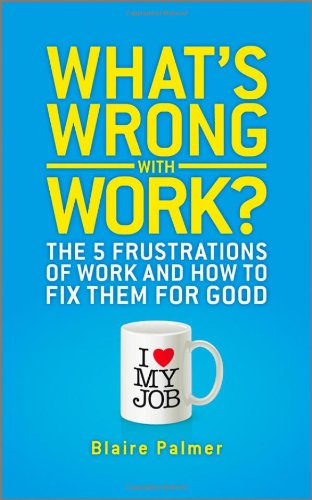What’s Wrong with Work Summary

6 min read ⌚

The 5 Frustrations of Work and How to Fix Them for Good
Do you hate your job? Are you sick and tired of meetings that seem to never end, of leaders who don’t know the basic laws of leadership, of juvenile office politics?
Well, so are we!
And so is Blaire Palmer who intends to help you fix your work-related problems for good.
There’s a catch, though!
She believes that there are only five. Think you can name about a thousand? So, did we.
But, let’s tell you what Palmer thinks and we might just be able to change your mind.
Who Should Read “What’s Wrong with Work”? And Why?
If you’re not a wealthy freelancer and you spend at least eight hours a day working, you’re bound to be interested in anything work-related. After all, it’s at least a third of your day we’re talking about!
However, if you’re not a manager, “What’s Wrong with Work” is not a book you may be interested in. Namely, all of the solutions proposed here can be implemented by middle or upper-echelon personnel only.
So, dear one-minute managers out there – read on!
About Blaire Palmer
 Blaire Palmer is one of the foremost leadership experts in the world. A former BBC Today producer, she became one of the first corporate coaches in the UK. She is a sought-after keynote speaker and a part-time columnist.
Blaire Palmer is one of the foremost leadership experts in the world. A former BBC Today producer, she became one of the first corporate coaches in the UK. She is a sought-after keynote speaker and a part-time columnist.
Palmer has so far authored three books: “The Hyper-creative Personality”, “The Recipe for Success”, and “What’s Wrong with Work.”
“What’s Wrong with Work Summary”
Put forward in an everyday discussion, Blaire Palmer’s question from her book’s title will probably get you rambling on and on about bosses, and colleagues, and projects, and whatnots!
We don’t blame you!
We think just like you and we believe that about 99% of the world’s population share our feelings!
In fact, so does Palmer. Regardless of the subtitle, her book isn’t really a magic wand which will transform your mechanical job into a rollercoaster experience! It’s not like she has a 5-step program to convert the accountant “you” into a lion tamer!
What she does have, however, are the recipes to get to the bottom of five frustrations of a more universal kind. Doing away with them, Palmer thinks, will make your office job much more pleasurable and fulfilling.
Of course, that doesn’t mean that you’ll start loving your job if you didn’t at least like it in the first place!
So, which are these five frustrations and what should you do about them?
Here we go, one by one.
1. Waste-of-Time Meetings
Now, that’s a problem you can relate to!
How can it not be! On average, you spend about 37% of your day on meetings, and about half of that time is practically wasted.
Let us do the math for you:
You spend on these fancy get-togethers about 60 hours a month or more than a whole workweek. And out of these hours, roughly 30 you do nothing productive. That amounts to throwing away about a workday per week!
Now, who would want that?
And that doesn’t even take into account the hangover effect! What is that, you ask? You know it, you’ve felt it! It’s the time you need to recuperate and go back to your usual self after the meeting!
If you’re a manager, the solution spells itself:
First, reduce the number of meetings to only the most important ones. Then, reduce the number of people required to go to each of these meetings. Those who don’t add up to the value, don’t really need to be there.
Finally, define the purpose and the goals of each meeting before it starts. And, don’t forget to prescribe time for each item on the agent.
So that you know when to stop!
2. Mis-Leadership
There are leaders and leaders!
The main difference is that the good ones have good strategies! And, from time to time, decide to restructure them!
Because, you see, if you’re a manager, there’s a good chance your employees hate you! And there’s an even better chance you don’t really know your employees.
That’s the root of the problem, and the place where the solution starts. It’s not about money: after a certain point, it neither inspires nor helps.
People are excited about working because of the achievements they reach, and the recognition they get. As a result of the work they do and the responsibilities they have. Due to the fact that they can advance and grow.
Then, rip the rewards.
3. Blurred Vision
It is the power of his vision which makes for a powerful leader!
Moreover, visions are not only the things which bind communities; they are what successful companies are built on.
So, have a clear vision for your company from the start!
And put it down in writing so that everyone knows it!
4. The Silo Mentality
Just like money incentives, competition is only great up to a certain point! Afterward, it creates silos, i.e. segregated workspace.
As a manager, it’s your duty to create an environment where competition is fun – not hostile!
A simple coffee might do! Create an out-of-the-office network which will strengthen the in-the-office bonds!
How hard can it be to train people who work the same job to not hate each other?
Because, remember: that’s enough for a work network to function!
5. Unfairness
You can be a little man and shout “it’s not fair” all you want to, but remedying unfairness starts with action!
And if you’re a manager, you must teach your employees to act. Because, how else would you find out if they think that something’s not fair!
So, teach them to act and share their views. Listen to them. And then act to your best judgements.
Even not acting right will make your employees feel better, once they know they’ve been heard.
Key Lessons from “What’s Wrong with Work”
1. The Meetings to End All Waste-of-Time Meetings
2. Take a Cup of Coffee with Your Employees
3. Ask Yourself Will Your Mummy Allow It
The Meetings to End All Waste-of-Time Meetings
Time-saving begins with restructuring your meetings. And when it comes to them, Blaire Palmer sides with Patrick Lencioni’s four meeting types strategy, as explained in “Death by Meeting”.
So, reduce all your meetings to these four types only: daily checks, weekly plans, monthly strategies, and quarterly overviews.
The daily checks should last no more than five minutes. The weekly plans should cap a week and last about an hour. The monthly strategies are a two-hour-per topic conferences. And the quarterly overviews are about the big stuff and concern only the upper echelons.
Take a Cup of Coffee with Your Employees
Whether it’s the company’s direction, or its internal structure, many things in your company depend on taking the time to drink a cup of coffee with your subordinates.
They will like you more, you’ll get to know them better. And instead of a hostile environment, you’ll create a fun workspace!
Ask Yourself Will Your Mummy Allow It
Many things are unfair in the world. Unfortunately, you look at all of them from your perspective only! But, can you stop doing this? After all, we’re all selfish and biased!
Well, you can’t really. But it does help to ask yourself if your mother would approve of your actions. A good rule of thumb is that If she doesn’t – you need to make amends!
Like this summary? We’d Like to invite you to download our free 12 min app, for more amazing summaries and audiobooks.
“What’s Wrong with Work” Quotes
Who can stop work being boring, frustrating, stressful, unhealthy, unfulfilling, limiting and meaningless? You. Share on X Leadership (and management) isn’t a science. It is an art. Share on X People working together can achieve far more than people slaving away in solitude. Share on X If you are open, no matter how thorny and unpopular the issue, people will respect you even if they don’t agree with your decision. Share on X Being a great leader-manager is about being a great person. People don’t want to follow a cardboard cut-out. They want to work alongside someone real. Share on XOur Critical Review
True, books which promise to solve all your work-related problems sound suspicious to begin with. However, “What’s Wrong with Work” is a bit – and just a bit –different. Not in the way that it is capable of making a heaven out of the office hell; but in the way that it helps nevertheless.
In other words, “What’s Wrong with Work” will certainly not make your job great again. But, it will make some aspects of it much more enjoyable.
As we wrote above, it is primarily directed at managers, so, if you’re not one, most of the tweaks proposed here may be out of your reach. In which case, the only thing you can do with the book is recommend it to your superior.
And hope that he will implement an suggestion or two.








